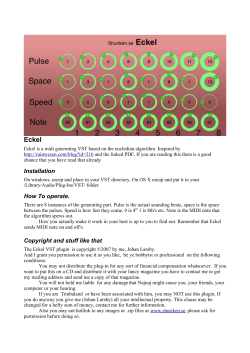
electronic music worksheet 1
Electronic muSic Electronic muSic is music in which electronic technology, now mostly computer-based, is used to access, make, explore and configure sound materials, and which is heard through loudspeakers. acouSmatic music is where we can’t see how the sound is made. Instead, we hear the sound through speakers. Electronic music is acousmatic music. live electronic music is where technology is used to make, change, or play sounds during live performance (usually on laptops). MUSIQUE CONCREtE (an Electronic Music artform) began with a group of German composers in the 1950s. These composers worked using magnetic tape, reel to reel, combined with acoustic instruments. Now, electronic music is recorded and sent via MIDI files (*.midi). MIDI (short for Musical Instrument Digital Interface) is a technical standard that describes a protocol, digital interface and connectors and allows a wide variety of electronic music instruments, computers, and other related devices to connect and communicate with one another. MIDI carries event messages that specify notation, pitch, velocity, control signals for parameters such as volume, vibrato, audio panning, cues, and clock signales that set and synchronize tempo between multiple devices. MIDI technology was standardised in 1983 by a panel of music industry representatives. MIDI allows for musicians to record in a home studio, compose via music notation software, and record their playing directly into computers. Electronic muSic is not so much a reaction against traditional instruments, but more an interest in, and an embracing of, new technology. In fact, a lot of electronic music uses traditional instruments in combination with electronic sounds, or traditional acoustic instruments are altered electronically. A Short hiStory of electronic music and electronic instruments: - 1902 - Telharmonium or Dynamaphone - electronic sounds over telephone lines - 1906 - Triode Vacuum Tube - amplification - 1919 - Theremin - two metal antennas controlled by position of the player’s hands - 1928 - Ondes-Martenot - similar to a theremin and uses a keyboard to play - 1928 - Trautonium - sound is made by pressing a resistor wire over a metal plate - 1929 - Hammond Organ - an electric organ - 1930 - Tape Recorder - the tape recorder is invented - 1950 - Musique Concrete - the first piece in this genre is composed - 1951 - Electronic Music Lab - the first studio is established in Cologne - 1952 - Clavivox Synthesizer - keyboard sound synthesizer and sequencer - 1956 - Algorithmic Composition - the first complete work of computer-assisted composition is made - 1959 - RCA Mark II Synthesizer - the first major voltage-controlled synthesizer is produced (with the help of a $175000 grant) - 1960s - Switched on Bach - this famous album features music of Bach played on a Moog synthesizer - 1970s - Real-time digital synthesis - computer systems featuring real-time digital signal processing are developed - 1980s - MIDI - the MIDI file is standardised, making studio composition easy and affordable - 1985 - Software - Macintosh releases the first sound design software offering hard-disk recording and editing of music, making computer composition easily available to the average consumer - 1990s - Real-time performance - computer-assisted music is able to be ‘played’ in live performance and becomes popular electronic muSic diScovery 1. What is ‘Electronic Music’? 2. What are the origins of Electronic Music? 3. What does MIDI stand for? 4. In what period of music history was MIDI developed and used? 5. List some electronic music instruments. gloSSary Research these terms online and write their definitions in the boxes below. Acousmatic MIDI Sequencer Dubbing Musique Concrete Synthesizer Feedback Remix Tape Loop Loops Sampler Technology dueStionS with no anSwerS.... Adapted from TES Australia worksheet. It is often said that what goes IN to creating music in this period of music is as important as what comes OUT. In other words: if a piece of music sounds dreadful, it doesn’t matter too much as long as the philosophy behind the creation of the music is well thought out! You may have strong views on the music we heard in class (Grainger’s Free Music Machine, Stockhausen’s electronic lab compositions etc) or you may be sitting on the fence to some extent. Have a think about the following questions and jot down some notes (not just ‘yes’ or ‘no’) - try to see the question from different angles and don’t just write the obvious! 1. Which is more important: to produce music that sounds nice, or to produce music that has heartfelt meaning, even if it doesn’t sound nice? 2. Is there such a thing as ‘good’ music? If so, what are the factors that make it good? 3. What constitutes music in the first place? Melody, rhythm, instruments...? Would you call bird-song ‘music’? 4. Comment on the following statement: “Music must express heartfelt emotion to be called ‘music’.” ELECtRONIC MUSIC COMPOSItION 1. Go to www.soundation.com 2. Create a free account using your email address and password. 3. Launch the ‘free studio’. Composition: Your task is to compose a dance-styled piece of music. Length: 1.5 minutes Structure: 5 sections Layers: - at least 3 percussion layers (loops) - at least 2 pitch layers (loops) - at least 1 virtual instrument layer (played into the computer and recorded over the layers) - some special effects Write your plan down below and keep notes of what you have done. INSTRUMENT Percussion layer 1: Percussion layer 2: Percussion layer 3: Pitch layer 1: Pitch layer 2: Virtual instrument 1: Special effects: SECTION 1 SECTION 2 SECTION 3 SECTION 4 SECTION 5
© Copyright 2025





















